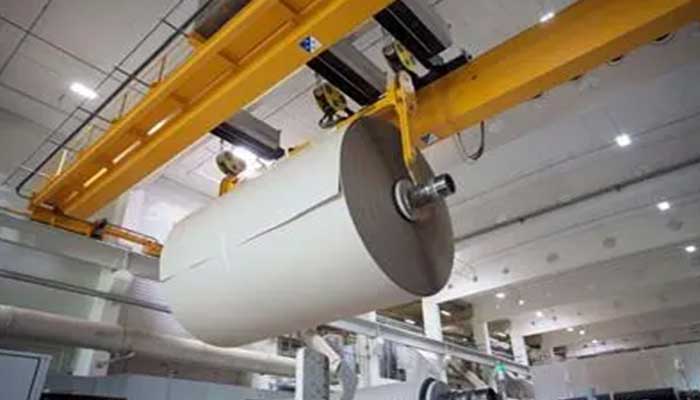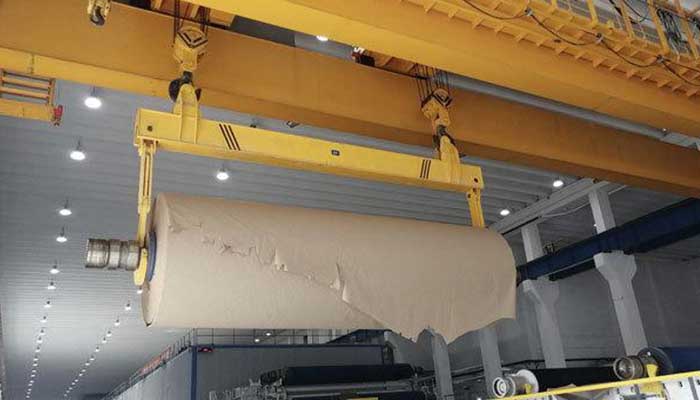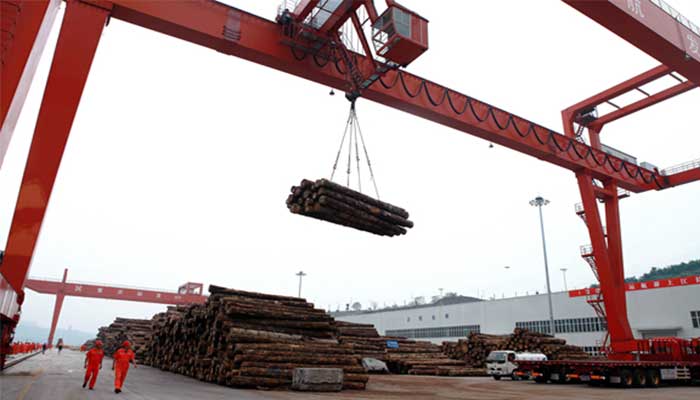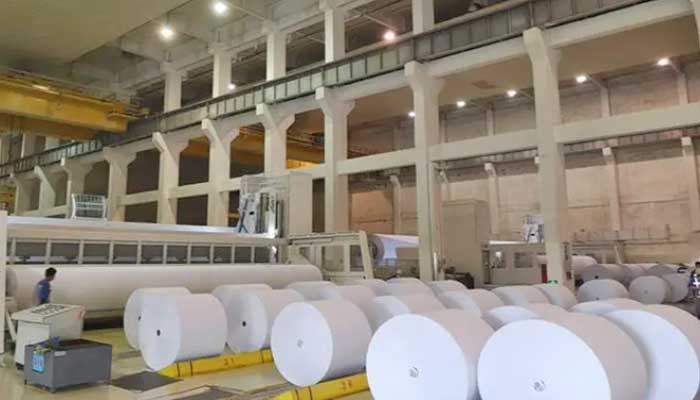30 Ton Overhead Cranes & Gantry Cranes for Integrated Paper Mills
Overhead Cranes and Gantry Crane Operation in Integrated Paper Mills: A Comprehensive Guide
Integrated paper mills are complex industrial facilities where raw materials like logs and timber undergo a series of processes to produce a variety of paper products. These mills typically house several interconnected operations, including raw material handling, pulp processing, paper machine areas, and maintenance workshops.
Efficient overhead crane operation plays a pivotal role in the seamless functioning of integrated paper mills. Overhead cranes are the workhorses of material handling, ensuring the timely and precise movement of logs, pulp bales, paper rolls, and maintenance tools. The reliability and performance of these cranes directly impact the overall productivity and operational efficiency of the mill.
This comprehensive guide aims to provide invaluable insights into the operation of overhead cranes within integrated paper mills. From exploring various crane designs to understanding their applications in different workshops, addressing common challenges, and offering practical tips for buyers and users, this guide is designed to be a go-to resource for anyone involved in the paper mill industry.
Types of Overhead Cranes in Integrated Paper Mills
Integrated paper mills rely on a variety of overhead cranes to facilitate the smooth flow of materials across different operational areas. Each crane type is uniquely designed to address specific requirements. Let's delve into the primary types employed within these facilities:
Single Girder Bridge Cranes
- Overview: Single Girder Bridge Cranes are versatile workhorses in integrated paper mills. They feature a single bridge beam supported by end trucks, providing cost-effective solutions for various applications.
- Applications: Efficient handling of logs and timber in raw material yards. Transporting materials within maintenance workshops.
- Key Considerations: Ideal for lighter to moderate loads. Excellent maneuverability in confined spaces.

- Overview: Double Girder Bridge Cranes are robust, capable of handling heavy loads. They feature two bridge beams, offering enhanced stability and lifting capacities.
- Applications: Continuous operation for paper rolls in paper machine areas. Precision handling in fine paper production.
- Key Considerations: Suitable for heavy-duty applications. Increased lifting heights and capacities.
Gantry Cranes
- Overview: Gantry Cranes are versatile and mobile, running on rails or tracks. They are suitable for outdoor and indoor material handling.
- Applications: Raw material handling in outdoor storage areas. Transporting heavy rolls in various production stages.
- Key Considerations: Offers flexibility in movement and coverage. Available in single and double leg configurations.
Jib Cranes
- Overview: Jib Cranes consist of a horizontal arm (jib) mounted to a vertical pillar or wall, providing localized lifting solutions.
- Applications: Tool and equipment handling in maintenance workshops. Handling small paper rolls in specific production areas.
- Key Considerations: Ideal for localized, precise lifting. Space-efficient design.
Specialty Cranes for Paper Roll and Coil Handling
- Overview: Specialty Cranes are customized for unique requirements, such as handling large paper rolls and coils.
- Applications: Coil handling in pulp workshops. Efficient roll handling in paper machine areas.
- Key Considerations: Customized designs for specific material characteristics. Specialized attachments for secure handling.
Gantry Cranes and Overhead Crane Applications in Integrated Paper Mills
Raw Material Handling
gantry crane for log and timber material handling
Logs and Timber Unloading
In the initial stages of paper production, the efficient unloading of raw materials is critical. Single Girder Bridge Cranes and Single Leg Gantry Cranes are commonly employed for this purpose. Their agility allows precise handling, preventing damage to logs and timber. Specialized log grapples or clamps enhance the gripping capabilities, ensuring a smooth unloading process.
Applications: Yard Operations: Handling logs and timber from trucks to storage yards.
Unloading Areas: Direct transfer of raw materials from transportation to processing.
Transporting Raw Materials to Processing Areas
After unloading, the next challenge is transporting raw materials to different processing areas within the mill. Double Girder Bridge Cranes and Double Leg Gantry Cranes are well-suited for this task. Their higher load capacities enable the movement of large quantities of logs or timber efficiently. Customized attachments, such as adjustable trolleys, enhance adaptability to varying load sizes.
Applications: Pulp Processing: Transporting raw materials to the pulp mill for further processing.
Paper Machine Areas: Supplying materials for paper production.
Pulp Mill Operations
Handling Processed Pulp Bales
Once raw materials undergo processing, the resulting pulp is often compressed into bales. Efficient handling of these pulp bales is essential for the subsequent stages of paper production. Double Leg Gantry Cranes and Coil Handling Cranes equipped with customized clamps are commonly employed. These cranes ensure precise lifting and placement of pulp bales, preventing damage and facilitating seamless operations.
Applications: Pulp Storage Areas: Stacking and retrieving compressed pulp bales.
Paper Machine Feed: Transporting pulp bales to the paper machine areas.
Coil Handling in Pulp Workshops
In specialized pulp workshops, coils are formed as part of the processing. Coil Handling Cranes with specialized attachments are vital for moving these dense cylindrical structures. These cranes provide stability and control during coil transportation, ensuring a smooth workflow in pulp-related workshops.
Applications: Coil Production Areas: Handling and transporting dense pulp coils.
Raw Material Processing: Efficient movement during various pulp-related processes.
Paper Machine Areas
Continuous Operation for Paper Rolls
In the heart of integrated paper mills, the paper machine areas require cranes that can ensure continuous operation. Single Girder Bridge Cranes and Double Girder Bridge Cranes equipped with roll handling attachments excel in this environment. These cranes facilitate the smooth movement of large paper rolls, ensuring an uninterrupted flow in the paper manufacturing process.
Applications: Roll Storage and Retrieval: Precise handling for storage and retrieval of large paper rolls.
Paper Machine Feed: Transporting rolls to maintain continuous operation.
Precision Handling in Fine Paper Production
Fine paper production demands a high level of precision in handling. Double Girder Bridge Cranes with customized roll lifters are specifically designed for precision handling in fine paper production areas. These cranes provide stability and control, crucial for ensuring the quality of the final product.
Applications: Fine Paper Production: Maneuvering rolls during delicate production processes.
Quality Control Areas: Precise movement for inspection and packaging.
Maintenance Workshops
Tool and Equipment Handling
Maintenance workshops in integrated paper mills require cranes that can efficiently handle various tools and equipment. Wall-Mounted Jib Cranes are often utilized for their compact design and versatility. Equipped with custom attachments, these cranes aid in the organized storage and retrieval of maintenance tools, ensuring they are readily available for maintenance personnel.
Applications: Tool Storage: Efficient organization and retrieval of maintenance tools.
Workstation Support: Assisting maintenance personnel in handling tools during tasks.
General Maintenance Operations
For broader maintenance operations, including the handling of components and equipment, Single Girder Bridge Cranes and Double Girder Bridge Cranes prove beneficial. Their adaptability and higher load capacities make them suitable for a wide range of maintenance tasks. Customized attachments, such as adjustable trolleys, enhance the versatility of these cranes.
- Applications: Equipment Handling: Lifting and transporting machinery components for maintenance.
- Facility-wide Support: Assisting in general maintenance tasks across the entire mill.
Workshop-Specific Overhead Crane Designs

Coil Handling Cranes for Pulp Workshops
Design Features
Coil Handling Cranes in pulp workshops are meticulously designed to meet the specific requirements of handling dense cylindrical structures. The key design features include:
- Robust Structure: Coil handling cranes boast a sturdy and robust construction, ensuring stability during the lifting and transporting of heavy coils.
- Customized Clamps: These cranes are equipped with specialized clamps designed to securely grip and support the cylindrical shape of pulp coils. The clamps can be tailored to the specific dimensions and characteristics of the coils.
- Variable Speed Controls: Precision is crucial when handling pulp coils. Variable speed controls allow operators to adjust the lifting and movement speeds, ensuring a controlled and smooth operation.
- Safety Systems: Coil handling cranes are integrated with advanced safety systems, including overload protection, emergency braking, and anti-sway features. These systems enhance operational safety and protect both personnel and equipment.
Applications and Benefits
Efficient Coil Movement: Coil handling cranes excel in efficiently moving dense pulp coils within the pulp workshops. Their customized clamps provide a secure grip, minimizing the risk of damage during handling.
- Reduced Downtime: The precise and controlled movement offered by these cranes contributes to a reduction in downtime. Coils can be transported seamlessly, ensuring a continuous workflow in pulp-related processes.
- Increased Productivity: With robust construction and specialized features, coil handling cranes contribute to increased productivity in pulp workshops. The ability to handle heavy coils with efficiency enhances overall operational output.
- Minimized Maintenance Needs: The design features of these cranes, coupled with advanced safety systems, contribute to minimizing maintenance requirements. This ensures that the cranes remain operational for extended periods, supporting consistent workshop activities.
Roll Handling Cranes in Paper Machine Areas
Design Considerations
Roll handling cranes in paper machine areas are specifically designed to address the unique challenges associated with the handling of large paper rolls. The key design considerations include:
- Double Girder Construction: Roll handling cranes often feature a double girder construction, providing increased stability and load-bearing capacity. This design is particularly suitable for handling the substantial weight of paper rolls.
- Customized Roll Lifters: The cranes are equipped with specialized roll lifters designed to securely grip and lift paper rolls. These lifters can be customized to accommodate different roll sizes and weights, ensuring versatility in handling various roll specifications.
- Precise Positioning Controls: Precision is crucial when positioning paper rolls during the manufacturing process. Roll handling cranes incorporate advanced controls for precise movements, allowing operators to position rolls with accuracy.
- Anti-Collision Systems: To enhance safety and prevent collisions, these cranes are equipped with anti-collision systems. These systems utilize sensors and advanced technology to detect and avoid obstacles, ensuring smooth and safe roll handling operations.
Enhancing Efficiency in Roll Handling
- Continuous Operation: The design of roll handling cranes is geared towards facilitating continuous operation in paper machine areas. The cranes are capable of seamlessly transporting rolls from storage to the paper machine, contributing to uninterrupted production.
- Quick Roll Changeovers: Roll handling cranes are designed to facilitate quick and efficient roll changeovers. The combination of precise controls and customized lifters allows for swift roll replacements, minimizing downtime in the paper manufacturing process.
- Improved Ergonomics: Consideration is given to the ergonomic aspects of crane operation. The design ensures that operators can efficiently control the crane and lift rolls with minimal physical strain, contributing to a safer and more comfortable working environment.
- Integration with Automation: Many roll handling cranes are designed to integrate with automation systems. This integration allows for streamlined and synchronized roll handling processes, optimizing efficiency and reducing the reliance on manual operations.
Maintenance Workshop Cranes
Compact and Versatile Designs
Maintenance workshop cranes are tailored to the unique needs of handling tools and equipment in confined spaces. The design features include:
- Compact Footprint: Maintenance workshop cranes are engineered with a compact footprint, allowing them to operate efficiently within limited space. This design facilitates easy maneuverability in workshop areas.
- Configurable Attachments: These cranes come with configurable attachments, ensuring versatility in handling various tools and equipment. Customized hooks, clamps, or tool-specific attachments can be easily incorporated into the crane design.
- Adjustable Height and Reach: The cranes feature adjustable height and reach options, allowing operators to position the load precisely. This flexibility is essential when working in areas with varying layouts or storage configurations.
- Ease of Operation: Maintenance workshop cranes are designed for ease of operation. Intuitive controls and user-friendly interfaces ensure that even operators with minimal experience can efficiently handle tools and equipment.
Safety Features for Maintenance Operations
- Overload Protection: To prevent accidents and equipment damage, maintenance workshop cranes are equipped with overload protection mechanisms. These systems automatically detect and respond to excessive loads, ensuring safe lifting operations.
- Emergency Braking Systems: In the event of an emergency or sudden stop, these cranes are equipped with emergency braking systems. This feature enhances safety by rapidly bringing the crane to a controlled stop, preventing potential accidents.
- Anti-Sway Technology: Maintenance workshop cranes incorporate anti-sway technology to minimize load sway during lifting and movement. This ensures that tools and equipment remain stable, reducing the risk of accidents and improving overall safety.
- Operator Safety Features: The cranes are designed with features that prioritize operator safety, including anti-collision systems, audible alarms, and visual indicators. These elements contribute to a safer working environment for maintenance personnel.
Typical Loads Handling in Integrated Paper Mills
Logs and Timber
Handling logs and timber is a fundamental aspect of material processing in integrated paper mills. Single Girder Bridge Cranes and Single Leg Gantry Cranes are commonly employed for efficient and precise handling. These cranes are equipped with specialized log grapples or clamps to secure the raw materials during unloading and transportation.
Applications: Yard Operations: Efficient movement of logs from storage to processing areas.
Processing Stations: Precise placement of logs for further processing.
Processed Pulp Bales
Processed pulp bales are a crucial intermediate product in the paper production process. Double Leg Gantry Cranes and Coil Handling Cranes with custom clamps excel in handling these compressed bales. Their robust design ensures secure lifting and placement, preventing damage to the pulp.
Applications: Pulp Storage Areas: Stacking and retrieving processed pulp bales.
Paper Machine Feed: Transporting pulp bales to paper machine areas.
Large Paper Rolls
The transportation of large paper rolls is a continuous operation in paper machine areas. Single Girder Bridge Cranes and Double Girder Bridge Cranes equipped with roll handling attachments efficiently move these rolls, ensuring an uninterrupted flow in paper manufacturing.
Applications: Roll Storage and Retrieval: Precise handling for storage and retrieval of large paper rolls.
Paper Machine Feed: Transporting rolls to maintain continuous operation.
Tools and Equipment in Maintenance Workshops
Maintenance workshop cranes play a vital role in handling various tools and equipment. Compact and versatile, these cranes efficiently maneuver within limited spaces, utilizing configurable attachments such as hooks or clamps for tool storage and retrieval.
Applications: Tool Storage: Organized and efficient retrieval of maintenance tools.
Workstation Support: Assisting maintenance personnel in handling tools during tasks.
Specialized Handling for Unique Materials
In specific instances, integrated paper mills may handle unique materials requiring specialized cranes. Depending on the material characteristics, customized crane solutions may be employed to ensure safe and efficient handling.
Applications: Unique Material Handling: Tailored crane solutions for specialized material handling requirements.
Common Questions and Challenges
Frequently Asked Questions for Crane Buyers
What crane design is suitable for raw material handling?
Selecting the appropriate crane design for raw material handling depends on the specific requirements of the integrated paper mill. For efficient handling of logs and timber, Single Girder Bridge Cranes or Single Leg Gantry Cranes with specialized log grapples or clamps are commonly recommended. These designs offer precision and agility during the unloading and transportation of raw materials.
How to optimize crane operation for continuous paper machine processes?
Optimizing crane operation for continuous paper machine processes involves considering the specific needs of paper machine areas. Double Girder Bridge Cranes with roll handling attachments are well-suited for efficiently moving large paper rolls, ensuring a seamless and uninterrupted operation. Regular maintenance, operator training, and integrating the crane with automation systems contribute to the optimization of crane operations.
Challenges in Crane Operation in Integrated Paper Mills
Addressing Heavy Load Handling Challenges
Handling heavy loads, such as logs, timber, and large paper rolls, poses a challenge that requires robust crane designs. Double Girder Bridge Cranes and Double Leg Gantry Cranes are engineered to address heavy load handling challenges. Implementing proper load distribution techniques, utilizing anti-sway technology, and ensuring regular equipment inspections are crucial in overcoming these challenges.
Ensuring Safety in High-Volume Operations
Safety is paramount, especially in high-volume operations where efficiency is key. Advanced safety features, including overload protection, emergency braking systems, and anti-collision technology, are incorporated into crane designs to mitigate risks. Operator training and adherence to safety protocols contribute to ensuring a secure working environment in integrated paper mills.
Best Practices for Overhead Crane Operation
Operator Training and Certification Programs
- Rigorous Training Programs: Implement comprehensive training programs for crane operators, covering equipment operation, safety protocols, and emergency procedures.
Provide hands-on training to ensure operators are proficient in maneuvering cranes under various conditions. - Certification Requirements: Establish certification requirements for crane operators, ensuring that they meet industry standards and are well-versed in safe and efficient crane operation.
Regularly update training programs to align with evolving technologies and safety regulations.
Regular Maintenance Schedules
- Scheduled Inspections: Implement routine crane inspections and maintenance schedules to identify and address potential issues before they escalate.
Conduct regular visual inspections by trained personnel and schedule detailed examinations by certified technicians. - Lubrication and Component Checks: Ensure proper lubrication of crane components to reduce friction and wear.
Regularly check critical components, such as wire ropes, hooks, and brakes, for signs of wear or damage and replace as necessary.
Emergency Procedures and Protocols
- Emergency Response Training: Provide crane operators and maintenance personnel with training on emergency response procedures.
Conduct periodic drills to ensure quick and effective responses in case of emergencies. - Emergency Communication Systems: Install reliable communication systems to facilitate immediate response during emergency situations.
Clearly communicate emergency protocols and exit routes to all personnel working in areas with overhead crane operations.
Enhancing Efficiency in Material Handling
- Integration with Automation: Explore automation solutions to optimize material handling processes, reduce manual intervention, and enhance overall efficiency.
Implement technologies like RFID and barcode systems for streamlined inventory management. - Technology-Assisted Controls: Equip cranes with technology-assisted controls, such as variable speed options and anti-sway technology, to improve precision and efficiency in material handling.
Integration with Other Equipment and Technologies
Automated Systems for Load Tracking
- Load Tracking Software: Implement automated systems that use load tracking software to monitor and track the movement of loads handled by overhead cranes.
Integrate load tracking with centralized control systems for real-time visibility into material handling processes. - Data Analysis for Optimization: Utilize data collected through load tracking systems to analyze material flow patterns and identify opportunities for optimization.
Implement predictive analytics to forecast maintenance needs and prevent downtime.
RFID and Barcode Integration for Inventory Management
- RFID Technology: Integrate RFID technology into overhead crane systems for efficient tracking of raw materials, processed goods, and equipment.
Enable RFID tags on loads for automatic identification and data capture, streamlining inventory management. - Barcode Scanning: Implement barcode scanning systems for quick and accurate identification of materials and products.
Integrate barcode data with inventory management software to enhance accuracy in tracking and reporting.
Robotics and AI in Crane Operation for Increased Efficiency
- Robotic Assistance: Explore robotic systems that work in conjunction with overhead cranes for tasks such as loading and unloading materials.
Integrate robotic assistance to handle repetitive and labor-intensive aspects of material handling. - AI-Enhanced Controls: Implement artificial intelligence (AI) algorithms in crane controls for dynamic load optimization and path planning.
Leverage AI to enhance crane operation by learning from historical data and adapting to changing operational conditions.
Considerations for Crane Buyers and Users
Facility Size and Layout Considerations
- Space Optimization: Evaluate the available space in the facility to determine the most suitable crane design and layout.
Choose cranes with compact footprints for confined areas and utilize gantry cranes for flexible coverage. - Workflow Efficiency: Consider the workflow and material flow within the facility when selecting crane types and their placement.
Optimize crane placement to minimize travel distances and maximize operational efficiency.
Load Capacity Requirements for Different Areas
- Tailored Load Capacities: Assess the load capacities required in various areas of the facility, considering the specific materials and processes involved.
Match crane capacities to the heaviest loads in each area to ensure optimal performance. - Adjustable Load Capacities: Choose cranes with adjustable load capacities or versatile attachments to accommodate varying load sizes in different operational zones.
Ensure that the selected cranes can handle both current and potential future load requirements.
Environmental Factors and Crane Durability
- Weather Resistance: Consider the environmental conditions in and around the facility, including temperature variations and exposure to elements.
Select cranes with weather-resistant features or implement protective measures to enhance durability. - Corrosion Protection: Assess the risk of corrosion in areas with high humidity or exposure to corrosive materials.
Choose cranes with corrosion-resistant materials or apply protective coatings to extend crane lifespan.
Compliance with Safety Standards
- Adherence to Regulations: Ensure that overhead cranes comply with local and international safety regulations and standards.
Verify that the selected cranes meet or exceed safety requirements to guarantee a secure working environment. - Safety Features Integration: Prioritize cranes equipped with advanced safety features, including overload protection, emergency braking systems, and anti-sway technology.
Regularly update safety protocols and provide ongoing training for crane operators to promote a safety-first culture.
Conclusion: Custom Overhead Cranes for Your Needs
In the diverse landscape of integrated paper mills, the selection and application of overhead cranes play a pivotal role in ensuring seamless operations. We explored various crane types, including Single Girder Bridge Cranes, Double Girder Bridge Cranes, Gantry Cranes, Jib Cranes, and specialized designs like those for coil and roll handling. Each crane type found its unique application across different sections of the mill, from raw material handling to maintenance workshops.
The significance of tailored crane solutions cannot be overstated. Matching the right crane design with specific operational requirements, load capacities, and environmental considerations is essential for optimizing efficiency. From logs and timber handling to the precision required in fine paper production, each area demands a customized approach to ensure safety, productivity, and longevity of equipment.
As technology continues to evolve, so does the landscape of overhead crane operations in paper mills. Automation, RFID integration, artificial intelligence, and robotics are shaping the future of material handling. The seamless integration of these technologies not only enhances operational efficiency but also contributes to predictive maintenance, reducing downtime and overall costs.
In conclusion, the selection, operation, and maintenance of overhead cranes in integrated paper mills require a holistic understanding of the unique demands of each section. By embracing tailored solutions and staying abreast of technological advancements, paper mills can navigate challenges and pave the way for a sustainable and efficient future in the industry.




